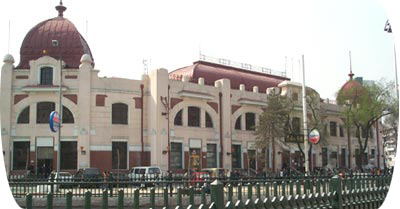 |
Heilongjiang Provincial Museum

Building the plane layout determine its elevation modeling and processing. As both sides of street construction, a square face and therefore should have three elevation to focus on, so that guests can see each point of a good landscape. First of all construction in the overall contour creation, adopted at the end of three rectangular flat dome and the two square at the end of flat dome, the building has greatly enriched form, this dome shape with the French classical features.
In the construction of left and right wings, dark red rectangle at the end of the Chen Shui-bian uplift in the shallow dome of the four Poding above the dome Uehara decorated with a blend of "new art" of cast iron, was replaced by the vertical and horizontal lines and simple ring Combination in the form of rich elegant dome shape, a legislature composed of the center, while the main square facing elevation modeling is more abundant. Two small corner of the dome at the end of flat, rectangular than those before the end of the dome added to a charming refined. Small-scale uplift in the dome of the square drums, with exquisite characterizations of the lines, to the end of the compact as a gyroscope-like top end, into the blue sky, and the Church of St. Nicholas Place Centre pointed tent roof to form a good echo And harmonization, both to promote the harmonious unity of the square space.
Small-scale construction as a whole, the ground for the two-story, underground layer. Elevation of each individual unit by highlighting the Bizhu be stressed that the end of extended eaves Bizhu become part of the parapet, which is Harbin "new art" construction of the parapet typical practice; second floor of each unit from top to bottom Different windows - the upper slightly Chen Shui-bian used the semi-circular window, decorated with stone-foot coupons, a central dark red Phi narrow awnings, compact and refined, is purely decorative elements; lower compared with the simple rectangular windows, the entrance to the center And level. The unit was obvious vertical composition, all dealing with similar units, such practices create a strong sense of rhythm, watch the construction of a section of each part as if to enjoy music, and two at the end of the dome is the climax of the music; Building Very elegant colors - khaki-coloured walls between the white lines to pin decorations and dark red dome, in the trees Ying Chen Yu Caryopteris under both clear and harmonious.
Looking back at those years, from the Church of St. Nicholas of wooden steps, the tree Yanying tranquil beautiful panoramic view of Moscow shopping malls, and from shopping malls If viewed on the platform, how the church is magnificent and sacred? » Today the church has already Huiqu, the provincial museum is still standing, a lot of change, most of the construction of a resumption of shopping malls into the original shape, the different times have changed, the shops are full of signs of a modern flavor, but is Unfortunately, this modern decoration is fresh, but building their own image and a lack of communication, and destroyed the building's overall image. Harbin as Class I protected buildings, people really want it to maintain youth and vigor.
Heilongjiang Provincial Museum is a local comprehensive museum, located in Harbin Nangang District No. 50 Red Army Street. The Russian-style building was built in 1904 building, has been more than half a century of history. Moscow initially designed for shopping malls, Eastern Province in 1922 to study relics museum, in 1936 changed its name to Manchukuo, the mainland branch in Harbin Academy of Sciences Museum, 1945 changed its name to Harbin Institute of Technology Research Museum.
People's Government in 1951 by the cultural sector to receive management, renamed the Songjiang Sheng Museum of Science.
1954 Songhua River in Heilongjiang Province with the merger, the last known as the Heilongjiang Provincial Museum.
The existing collection of the Museum of about 10,000 over 10, finishing the storage of natural specimens of about 8,000. More than 2,700 pieces of historical relics, a cultural relics, specimens 55. In the history of the Song Dynasty "Silkworm texture map", "Nine Songs map", the Qing Dynasty, "the Western Regions Yu map volumes," and Hezhe, Oroqen, Ewenki, John Erdeng of national heritage.
[1] [2] |
|